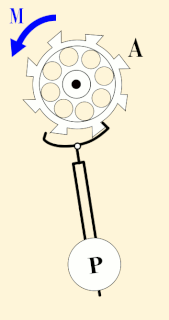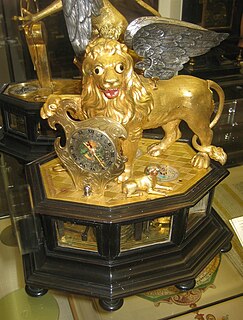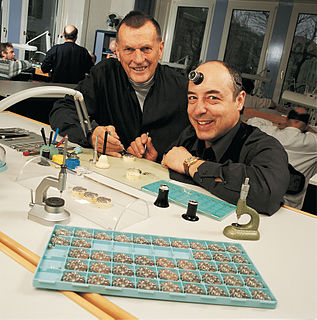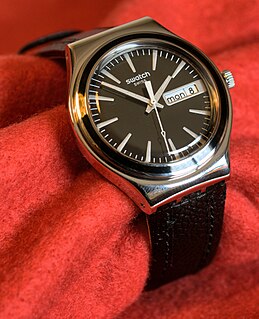Structure
Today the association is national in scope, and is loosely organised into working groups, both local groups (in Berlin, Dresden, Franconia, Frankfurt, Furtwangen, Hamburg, Cologne, Mannheim, Munich and Stuttgart) and special interest groups (wristwatches, electrical horology, restoration, sundials, pocket watches, tower clocks, and horological science).

A pocket watch is a watch that is made to be carried in a pocket, as opposed to a wristwatch, which is strapped to the wrist.
This page is based on this
Wikipedia article Text is available under the
CC BY-SA 4.0 license; additional terms may apply.
Images, videos and audio are available under their respective licenses.

The second is the base unit of time in the International System of Units (SI), commonly understood and historically defined as 1⁄86400 of a day – this factor derived from the division of the day first into 24 hours, then to 60 minutes and finally to 60 seconds each. Mechanical and electric clocks and watches usually have a face with 60 tickmarks representing seconds and minutes, traversed by a second hand and minute hand. Digital clocks and watches often have a two-digit counter that cycles through seconds. The second is also part of several other units of measurement like meters per second for velocity, meters per second per second for acceleration, and per second for frequency.

A watchmaker is an artisan who makes and repairs watches. Since a majority of watches are now factory made, most modern watchmakers only repair watches. However, originally they were master craftsmen who built watches, including all their parts, by hand. Modern watchmakers, when required to repair older watches, for which replacement parts may not be available, must have fabrication skills, and can typically manufacture replacements for many of the parts found in a watch. The term clockmaker refers to an equivalent occupation specializing in clocks.

A clock face, or dial, is the part of an analog clock that displays the time through the use of a fixed-numbered dial or dials and moving hands. In its most basic form, recognized throughout the world, the periphery of the dial is numbered 1 through 12 indicating the hours in a 12-hour cycle, and a short hour hand makes two revolutions in a day. A long minute hand makes one revolution every hour. The face may also include a second hand, which makes one revolution per minute. The term is less commonly used for the time display on digital clocks and watches.

An escapement is a mechanical linkage in mechanical watches and clocks that gives impulses to the timekeeping element and periodically releases the gear train to move forward, advancing the clock's hands. The impulse action transfers energy to the clock's timekeeping element to replace the energy lost to friction during its cycle and keep the timekeeper oscillating. The escapement is driven by force from a coiled spring or a suspended weight, transmitted through the timepiece's gear train. Each swing of the pendulum or balance wheel releases a tooth of the escapement's escape wheel gear, allowing the clock's gear train to advance or "escape" by a fixed amount. This regular periodic advancement moves the clock's hands forward at a steady rate. At the same time the tooth gives the timekeeping element a push, before another tooth catches on the escapement's pallet, returning the escapement to its "locked" state. The sudden stopping of the escapement's tooth is what generates the characteristic "ticking" sound heard in operating mechanical clocks and watches. The first mechanical escapement, the verge escapement, was invented in medieval Europe during the 13th century, and was the crucial innovation which lead to the development of the mechanical clock. The design of the escapement has a large effect on a timepiece's accuracy, and improvements in escapement design drove improvements in time measurement during the era of mechanical timekeeping from the 13th through the 19th century.

A striking clock is a clock that sounds the hours audibly on a bell or gong. In 12-hour striking, used most commonly in striking clocks today, the clock strikes once at 1:00 A.M., twice at 2:00 A.M., continuing in this way up to twelve times at 12:00 P.M., then starts again, striking once at 1:00 P.M., twice at 2:00 P.M., up to twelve times at 12:00 A.M.
The American Watchmakers-Clockmakers Institute (AWCI) is a not-for-profit trade association based in the United States that is dedicated to the advancement of the modern watch industry, from which it receives a significant portion of its funding. While the AWCI is an American organization, it also has members throughout the world.

A Japanese clock is a mechanical clock that has been made to tell traditional Japanese time. Mechanical clocks were introduced into Japan by Jesuit missionaries or Dutch merchants in the 16th century. These clocks were of the lantern clock design, typically made of brass or iron, and used the relatively primitive verge and foliot escapement. Tokugawa Ieyasu owned a lantern clock of European manufacture.

The German Clock Museum is situated near the centre of the Black Forest town of Furtwangen im Schwarzwald, a historic centre of clockmaking. It features permanent and temporary exhibits on the history of timekeeping. The museum is part of the local technical college.
The National Watch and Clock Library is one of the world's pre-eminent libraries devoted to horology and is located in Columbia, Pennsylvania, United States.

The National Watch and Clock Museum (USA) (NWCM), located in Columbia, Pennsylvania, is one of a very few museums in the United States dedicated solely to horology, which is the history, science and art of timekeeping and timekeepers.

For thousands of years, devices have been used to measure and keep track of time. The current sexagesimal system of time measurement dates to approximately 2000 BC from the Sumerians.

The Uhrenmuseum Beyer is located in the heart of the city of Zürich, Switzerland and is one of the world's leading private museums dedicated to horology.

The American Clock & Watch Museum (ACWM), located in Bristol, Connecticut, is one of a very few museums in the United States dedicated solely to horology, which is the history, science and art of timekeeping and timekeepers. Located in the heart of the historic center of American clockmaking, ACWM is the world's preeminent horological museum in the area of American clocks, primarily industrial-made clocks of the 19th and early 20th century.

Ludwig Oechslin is an Swiss watchmaker, designer and inventor.


















